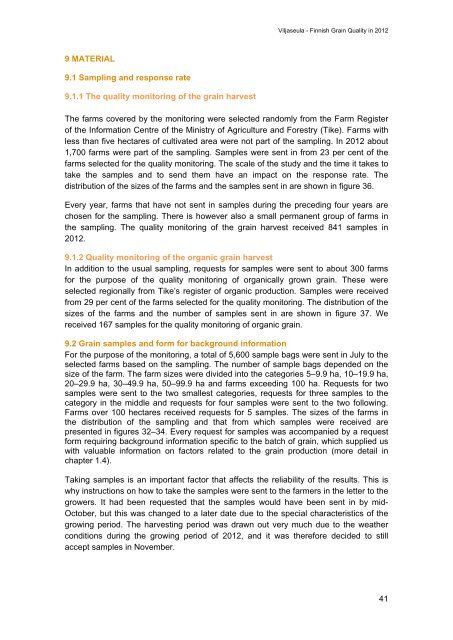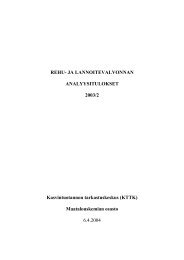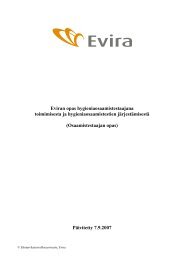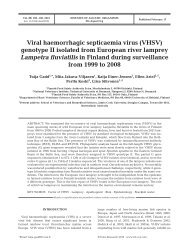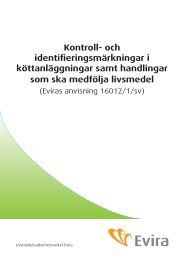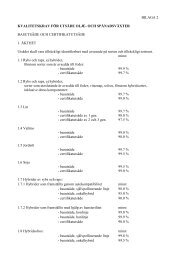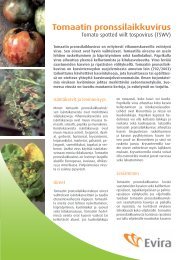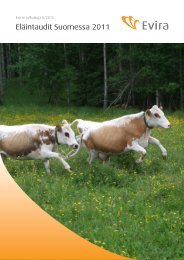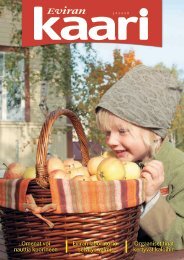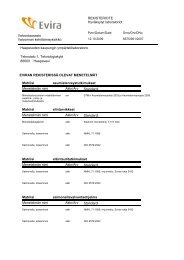Download PDF, 1698 kB - Evira
Download PDF, 1698 kB - Evira
Download PDF, 1698 kB - Evira
You also want an ePaper? Increase the reach of your titles
YUMPU automatically turns print PDFs into web optimized ePapers that Google loves.
9 MATERIAL<br />
9.1 Sampling and response rate<br />
9.1.1 The quality monitoring of the grain harvest<br />
Viljaseula - Finnish Grain Quality in 2012<br />
The farms covered by the monitoring were selected randomly from the Farm Register<br />
of the Information Centre of the Ministry of Agriculture and Forestry (Tike). Farms with<br />
less than five hectares of cultivated area were not part of the sampling. In 2012 about<br />
1,700 farms were part of the sampling. Samples were sent in from 23 per cent of the<br />
farms selected for the quality monitoring. The scale of the study and the time it takes to<br />
take the samples and to send them have an impact on the response rate. The<br />
distribution of the sizes of the farms and the samples sent in are shown in figure 36.<br />
Every year, farms that have not sent in samples during the preceding four years are<br />
chosen for the sampling. There is however also a small permanent group of farms in<br />
the sampling. The quality monitoring of the grain harvest received 841 samples in<br />
2012.<br />
9.1.2 Quality monitoring of the organic grain harvest<br />
In addition to the usual sampling, requests for samples were sent to about 300 farms<br />
for the purpose of the quality monitoring of organically grown grain. These were<br />
selected regionally from Tike’s register of organic production. Samples were received<br />
from 29 per cent of the farms selected for the quality monitoring. The distribution of the<br />
sizes of the farms and the number of samples sent in are shown in figure 37. We<br />
received 167 samples for the quality monitoring of organic grain.<br />
9.2 Grain samples and form for background information<br />
For the purpose of the monitoring, a total of 5,600 sample bags were sent in July to the<br />
selected farms based on the sampling. The number of sample bags depended on the<br />
size of the farm. The farm sizes were divided into the categories 5–9.9 ha, 10–19.9 ha,<br />
20–29.9 ha, 30–49.9 ha, 50–99.9 ha and farms exceeding 100 ha. Requests for two<br />
samples were sent to the two smallest categories, requests for three samples to the<br />
category in the middle and requests for four samples were sent to the two following.<br />
Farms over 100 hectares received requests for 5 samples. The sizes of the farms in<br />
the distribution of the sampling and that from which samples were received are<br />
presented in figures 32–34. Every request for samples was accompanied by a request<br />
form requiring background information specific to the batch of grain, which supplied us<br />
with valuable information on factors related to the grain production (more detail in<br />
chapter 1.4).<br />
Taking samples is an important factor that affects the reliability of the results. This is<br />
why instructions on how to take the samples were sent to the farmers in the letter to the<br />
growers. It had been requested that the samples would have been sent in by mid-<br />
October, but this was changed to a later date due to the special characteristics of the<br />
growing period. The harvesting period was drawn out very much due to the weather<br />
conditions during the growing period of 2012, and it was therefore decided to still<br />
accept samples in November.<br />
41


